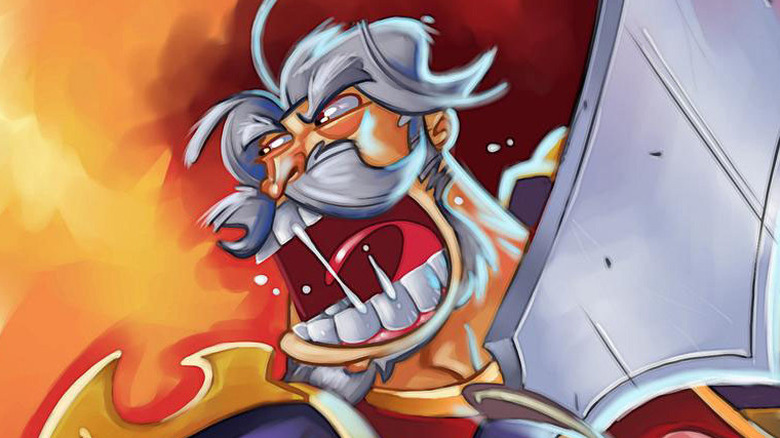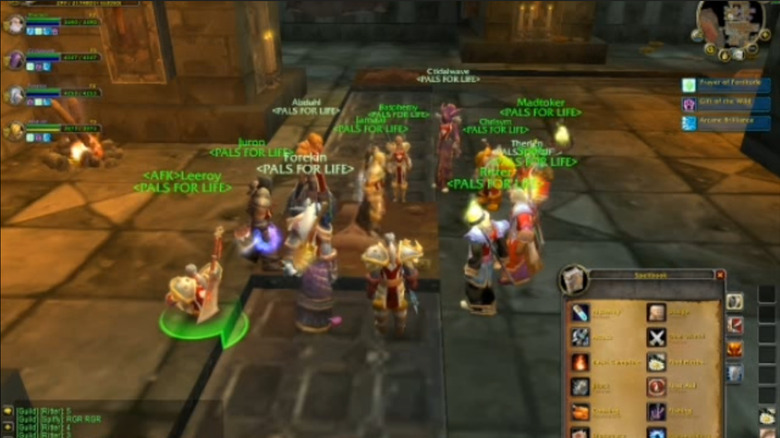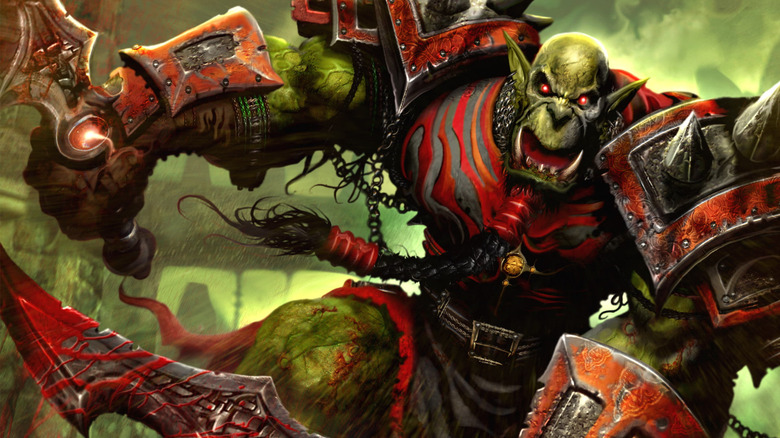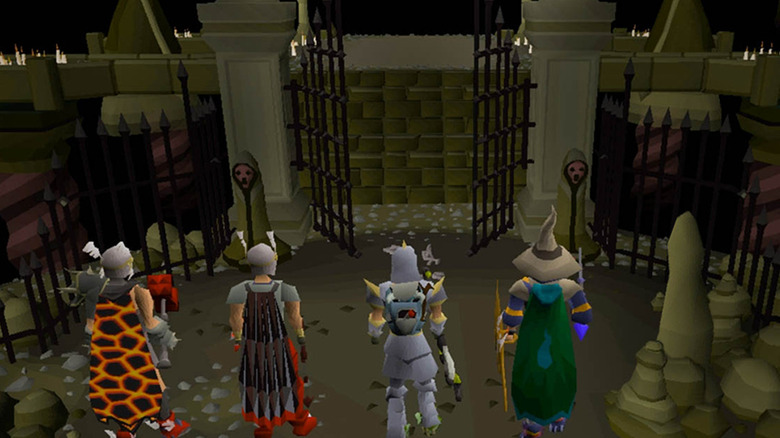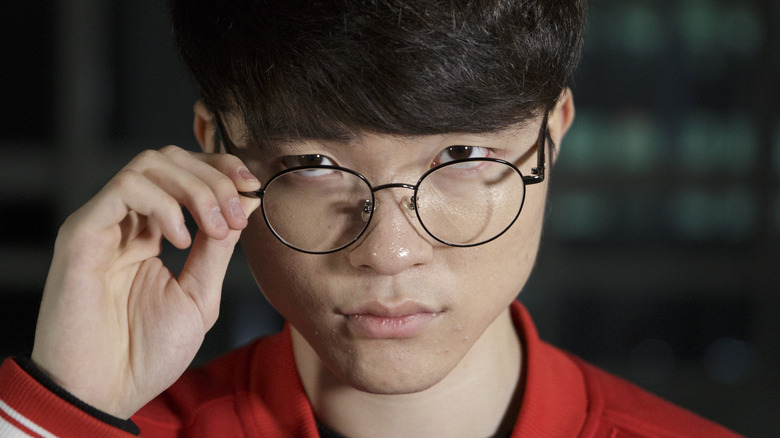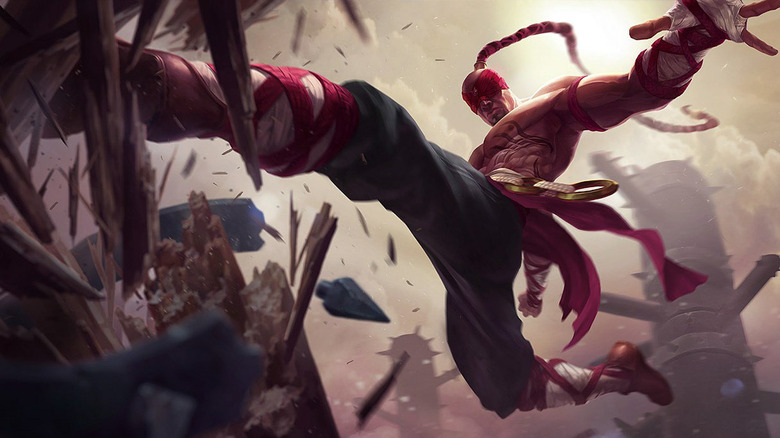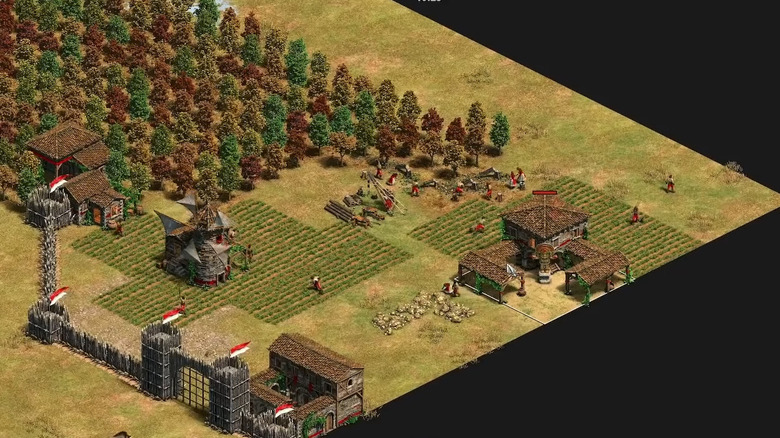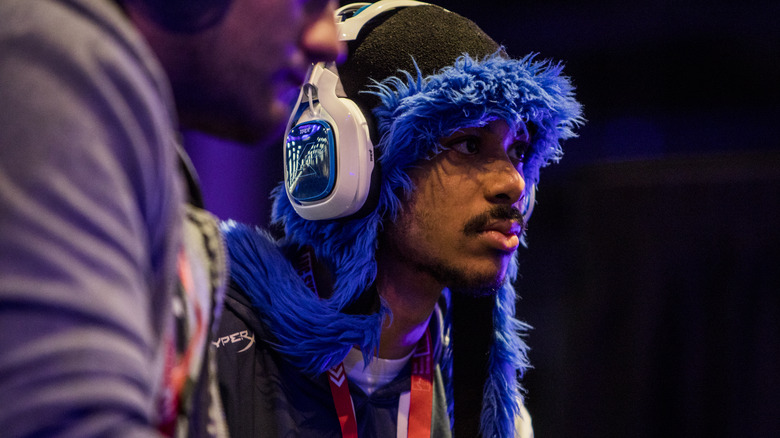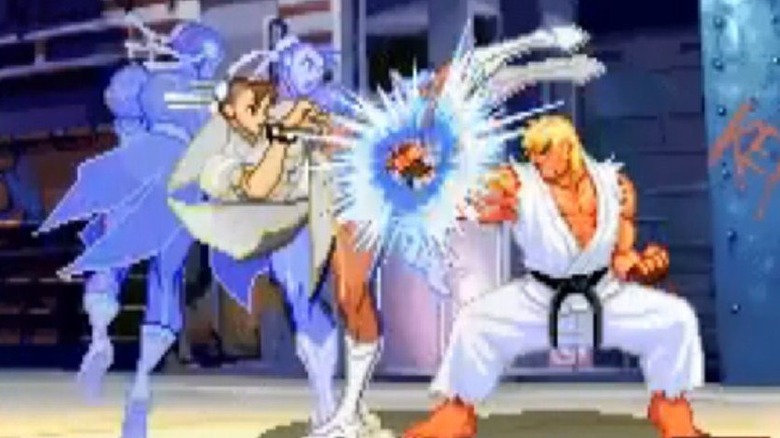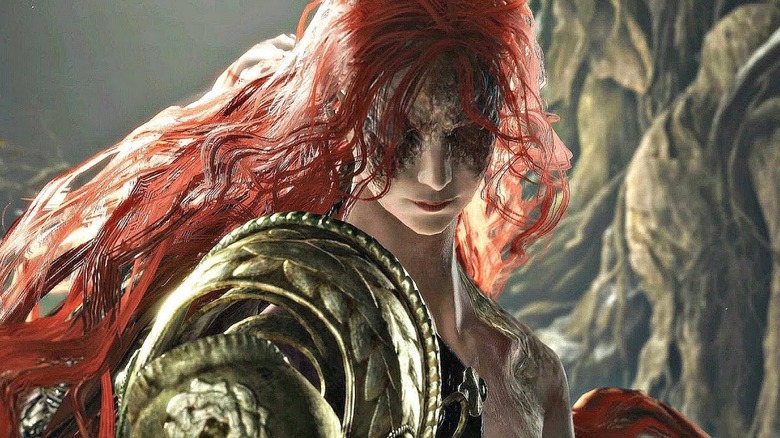The Most Legendary Players In Gaming
Video games connect their consumers like no other medium. The language of controllers is universal — players on different sides of the world can communicate through game actions and shared phrases like "GG." Games are a unique in the ways in which they help players feel less alone.
User-generated communities for video games likewise serve as a connecting thread that creates a kind of shared consciousness between players, complete with inside jokes and memes. Content creators and forums can then bind together the most meaningful aspects of a game's lore, player base, and memories.
These collective memories sometimes go on to form larger myths that transcend into legends. Older genres like MMORPGs, RTS games, and Fighting games have seemingly lent themselves more to these mythological players. Legends can be born from anywhere; they can spring from some unorthodox, game-changing style of play, supreme talent, or even just a silly joke that connected with everyone. What follows is a rundown of some of gaming's most legendary players.
Leeroy Jenkins
Ask anyone — even people with no background in gaming whatsoever — who Leeroy Jenkins is and they will probably respond with his iconic battle cry: "LEEEEEROOYYY JENNKINNNNNSSSS." The original video of a player rushing into battle (now re-uploaded in countless places) was posted back in 2005 and instantly became a viral meme racking up millions of views within its first few months.
The clip became popular because it successfully and hilariously blurred the line between a joke amongst friends with the stereotype of "World of Warcraft" nerds taking the game way too seriously. Ben Schulz, the iconic voice and player behind Leeroy Jenkins, confirmed in an interview with theScore esports that the viral clip came as a result of guild-recruitment efforts. The inside baseball references and war cry were all non-scripted jokes. But still, the video was a joke intended to generate attention for the guild — and it succeeded.
Not only did the clip garner buzz for the guild, it garnered legendary status within pop culture as a whole. Leeroy Jenkins' popularity grew so much that "Jeopardy!" dedicated a question to him, "South Park" referenced him in its famous "World of Warcraft" episode, Blizzard made him into a legendary card in "Hearthstone", and the US military even used his namesake as part of its mission control communications (per theScore esports). While Leeroy Jenkins' debut wasn't as spontaneous as it seemed, he stands as one of gaming's most memorable contributions to popular culture.
Angwe
In its early days, "World of Warcraft" epitomized the feeling of being part of a larger world due to the design of its game systems. Each server acted as a siloed version of the game, disconnected from the rest. Player-to-player communication was required to advance through the game, and players all shared the same ground-space because flying mounts didn't exist yet. This combination of factors led to player reputations mattering a lot on each server.
But where some chose cooperation, others chose the path of chaos. An infamous Orc Rogue named Angwe made it his mission to terrorize the Alliance players of the Dethecus server back in the earliest days of "World of Warcraft." He stalked Menethil Harbor, an Alliance-controlled port city that acted as both a crucial link within the global travel network and a mid-tier leveling zone.
As recorded in a detailed personal log, Angwe would stalk the harbor for more than 9 hours a day, killing any low-level character in sight. The Alliance quickly grew to hate Angwe, sending him messages like, "Angwe if your goal is to ruin my day, you have succeeded." Detailed forum posts covering how to avoid Angwe popped up out of the Alliance (per MadSeasonShow). Angwe would carry his antics even further, creating an Alliance account under the name "Angwespy" in order to sabotage their plans to avoid him. Like a true local legend, Angwe unmistakably left his mark on Dethecus.
Zezima
"RuneScape," released all the way back in 2001, is still one of the most popular MMORPGs on the market. Its continued success revolves around many factors, but an unmistakable anchoring factor for the game's popularity is its uber-dedicated community. MMORPGs, if successful, tend to produce hardcore fanbases, and "RuneScape" is no different.
Perhaps no player has become a bigger legend within the "RuneScape" community than Zezima. As one of the best players during the game;s peak popularity between 2004-2007, Zezima proved his acuity by accomplishing many feats before anyone else. He was the first player to max out the skill cap for Slaying, with skills like Cooking and Farming following soon after (per OSRSGuide). Beyond that, he was the first player to reach 1 billion total character experience points. Anybody who has played "RuneScape" knows that grinding these skills to their peak must have been utterly monotonous, no matter how impressive.
As a result of Zezima's list of accomplishments, he became a living legend within "RuneScape." Wherever he went, the general player chat around him morphed into paparazzi surrounding a celebrity. However, not much is known about Zezima as a real person. Besides a grainy photo from around two decades ago, nobody really knows what Zezima looks like, adding even further to his mythical status. Just a couple of years ago, Zezima was spotted in "Old School RuneScape" by a redditor and the community still is enamoured with him!
Faker
The competitive nature of esports can bring out the best of players, with massive gaming organizations supporting the proper onboarding, development, and execution of team dynamics. The skill required for a player to reach these organizational and league peaks is extraordinary. But sometimes, a truly incredible player emerges amongst the already-extraordinary gamers to stamp their name into the history books as one of the greatest of all time.
As noted by outlets like Hotspawn and Ginx.tv, T1's Faker is often considered the best "League of Legends" player of all time. His accomplishments date back to the start of his career in Season 3, racking up three World Championships, two MSI Championships, ten LCK season Championships, and three LCK MVP awards, amongst other smaller titles. He is also responsible for one of the best highlight clips ever produced in "League of Legends."
Faker's mastery has been compared to Michael Jordan's dominance in the NBA by ESPN, with similarities between the two's uncanny knack for winning games. Faker's career has lasted much longer than normal "League of Legends" pros, and he even had some doubters going into the regular season of 2021 (per theScore esports). Faker more than silenced the haters when his team secured the first perfect season in "LoL" history (per Inven Global), not losing any match on their way to a split championship. Now, "the Faker of [insert game here]" is a handle used to describe players of supernatural skill, standing head and shoulders above already exalted crowds.
Insec
Lee Sin is one of the most skill-intensive characters in "League of Legends." In order to play Lee Sin well, players must master each of his seven total abilities (whereas most characters only have four abilities). Lee Sin's ultimate, Dragon Rage, is a devastating roundhouse kick that stuns and sends its recipient careening backwards across the screen.
Accordingly, Insec is one the most famous professional players in "League of Legends." His career lasted seven years in Korea and China, during which time he was known as one of the most feared Junglers between Seasons 3 and 5. His popularity and intimidating presence came about because he took Lee Sin to unseen heights. Insec used Lee Sin's supreme mobility, either using a ward-jump technique with Lee Sin's Safeguard move or using the Flash Summoner Spell, to surprise enemies from behind with the Dragon Rage kick. This quick-twitch technique would send priority targets straight into the maw of Insec's team with little to no counter-play (per ProGuides).
Players, casters, and community members immediately took to calling this combo an "Insec," and it still exists as a known term to this day. If a Lee Sin player wants to become better at the champion, then learning how to do an "Insec" is the first thing to do, because teams have come to learn and expect that an "Insec" kick is one of Lee Sin's best uses.
Fatslob
"Age of Empires 2" was released back in 1999, but for more than 2 decades, "Age of Empires 2" has stood the test of time and even got a remastered "Definitive Edition" in 2019. Part of the game's continued popularity is due to its wide range of playable civilizations and maps, which are constantly updated by an active modding community. The original release came with 13 playable civilizations, but after many expansions, there are now 42 total playable civilizations.
But for some, that variety is meaningless. There is a renowned community member in "Age of Empires 2" who has, for more than 15 years now, played on the exact same map with the exact same rules. Every. Single. Game.
Fatslob has been creating custom joinable lobbies for the better half of two decades with the following ruleset: 1v1, both players must play Vikings, and the map must be Black Forest. T90Official, a YouTube channel dedicated to "Age of Empires 2" content, has followed parts of Fatslob's journey through the years. And that journey has been an unchanging, unwavering testament to determination, refinement, and (possibly) obsession.
Whether or not Fatslob is a good player doesn't matter, all that matters is that the Earth keeps revolving around the sun, the Moon keeps revolving around the Earth, and that Fatslob keeps queuing up 1v1 Vikings on Black Forest. These must remain universal constants.
Corner Boi
Similar to Fatslob's brand of repetitive gameplay, Corner Boi is another mainstay of "Age of Empires 2" who has made their mark on the decades-spanning RTS masterpiece. Again tracked by T90Official, Corner Boi is a "Low-Elo" legend (what some would call a bad player) who earned notoriety through their unique style of gameplay and recognizable name.
"Age of Empires 2" typically has a slow early game in which players build their Town Centers and venture out nearby to gather resources to get things rolling. Players have the option of scouting to find the optimal local spot to plant their Town Center, which generally only takes a few seconds. Corner Boi, on the other hand, uses this scouting time to find where the game's square map meets in a corner. This can fully take up the first few minutes of the game, setting him very far back in terms of production speed, but he also gains two invisible walls on his backside that he never has to defend.
Corner Boi's defensive posturing inevitably invites the opponent to attack. Every game for Corner Boi emulates the Battle of Helm's Deep from "The Lord of the Rings," complete with a small host of well-positioned defenders holding off waves of invaders. Whether or not it ends with a ransacking is up to the ebbs and flows of each match — but regardless, Corner Boi remains true to his namesake strategy.
Sonic Fox
Fighting games, dating back to arcade classics like "Street Fighter 2," have long existed as one of the ultimate esports genres. Quite simply put, there is no luck involved with winning a fighting game match.
Sonic Fox has claimed the top spot of active fighting game players since their competitive career really took off in late 2017. Sonic Fox had already won an EVO title back in 2014 for "Injustice: Gods Among Us," doing so when they were only 16 years old (per Wired). But their winning ways were only starting, and Sonic Fox would go on to win titles for "Injustice 2," "Mortal Kombat X," and "Dragon Ball FighterZ," marking their place as one of the best fighting game players of all time.
One of their most memorable moments in building that legendary resume came as a result of a grudge match. Perfect Legend is a fighting-game pro with EVO titles under his own belt who went up against Sonic Fox in a first-to-ten match after the youngster started their hotstreak in "Mortal Kombat X." Sonic Fox won all ten games in one of the most hyped match-ups in fighting game history. A following best-of-five matchup went pretty much the same way, cementing Sonic Fox's legendary status for many fans.
Daigo
For fighting games to stand out amongst their competition, they typically need a novel mechanic of some kind. "Street Fighter 3" perfected the parrying mechanic that allowed players to gamble on their defensive maneuvers. Blocking attacks in "Street Fighter" games greatly lessens the blow, but small amounts of HP are still chipped away when using blocks. Parries, on the other hand, could be performed by blocking within a certain frame threshold of the attack landing (generally 6-10 frames), and instead of taking a small chip of damage, the player would negate all damage entirely and set themselves up for a quick counterattack.
At EVO 2014, a matchup between all-time great players Daigo Umehara and Justin Wong produced the most legendary fighting game clip of all time in "Street Fighter 3," known as "Evo Moment #37." In the match, Justin had Daigo on the ropes, only needing to land one single attack or have multiple attacks block-chipped for the set to end. Justin's character, Chun-Li, had an ultimate ability ready that threw out 17 rapid-fire attacks, so using it in that situation was seemingly a kill-move, simply because nobody could parry 17 frame-perfect attacks in a row — except for Daigo.
From one parry into another, the crowd became more riled up. A few seconds later Daigo, had done the impossible and counter-attacked for the win. Nothing cements legendary status more than doing what was once thought impossible, and Daigo proved he belongs among fighting game royalty.
Let me solo her
The release of "Elden Ring" in early 2022 broke market expectations for total copies sold. The games publisher, Bandai Namco, expected only four million total copies to be sold in the game's first five weeks on the market. Instead, "Elden Ring" ended up selling over 12 million copies in that time period.
The game's overwhelming popularity has cultivated a dedicated and tight-knit community, drawing from FromSoftware's lineage of Soulsborne fans. The game's soft-multiplayer capabilities have allowed that community to interact with each other in-game by allowing players to write messages across worlds using Tarnished Fingers. Players have used these powers for simple jokes, misdirection, and lamentations, but an unassuming hero has emerged from the community for using a friendly summon sign outside of the domain of the game's most challenging boss. That sign bears a simple phrase: "Let me solo her."
When this player's golden summon sign is read, a ghostly vision of the katana-weilding warrior appears, naked but for a ragged loincloth and a pot on his head. When summoned, he performs his sworn duty, taking on Malenia all on his own — and usually bringing home an impressive victory. This player, Klein Tsuboi on YouTube, has become a fan favorite, inspiring tons of fan art, Summon mods, and stories shared among the "Elden Ring" community. His legend has grown to such heights that even the publisher of "Elden Ring" has rewarded him for his many contributions.

